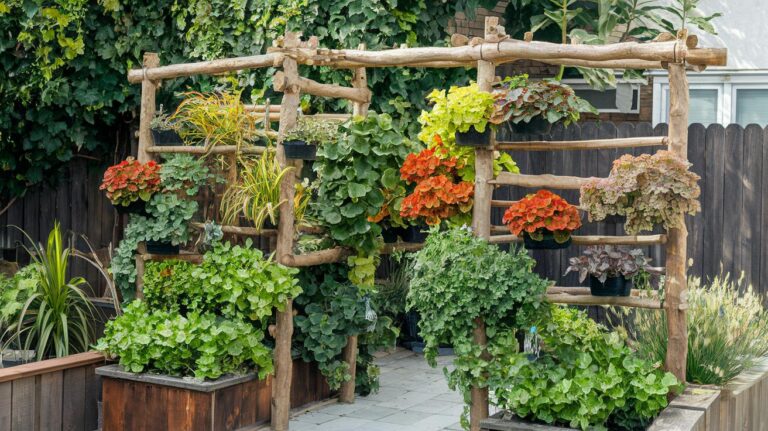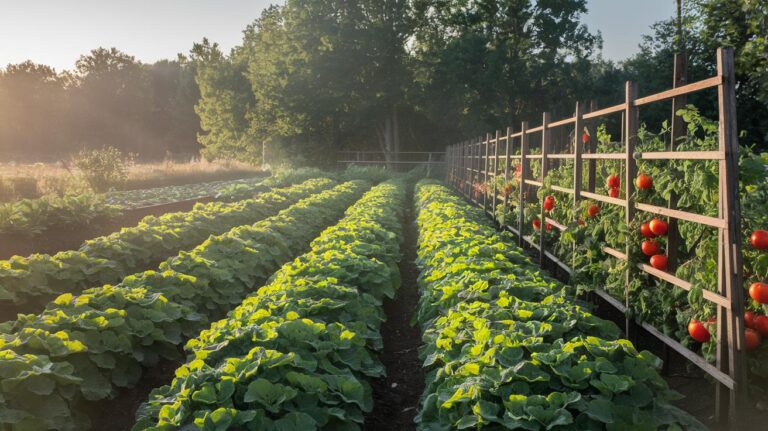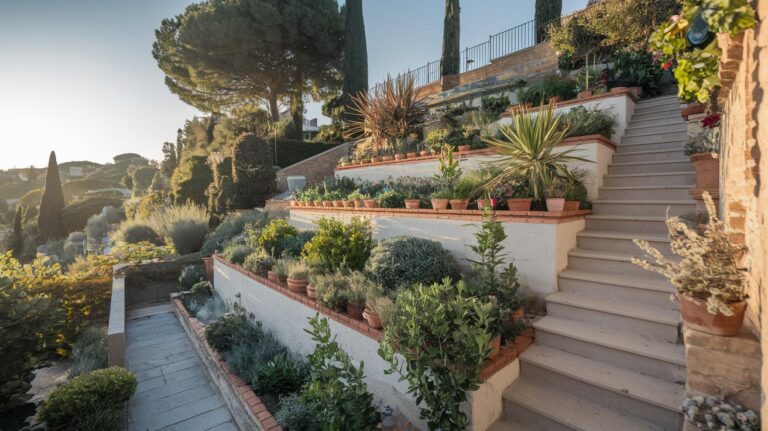Hummingbird Garden Design Ideas Stunning Blooms
Have you ever pictured tiny hummingbirds zooming through your garden? These little wonders flap their wings up to eighty times a second, always chasing sweet nectar (flower juice) and a cool, shady spot.
Picture winding paths of blooms, colorful flower clusters, and bright red focal blossoms that shout “come here” like a neon sign. By using smart sun mapping (tracking how much sun each spot gets), each flower soaks up just the right light.
So grab a notebook. I’m sharing my layout tips: plant in groups of three or five for a natural look, tuck in shady rest areas, and sprinkle in pops of bold color. You’ll end up with a backyard that truly hums with life.
Essential Layout Elements for hummingbird garden design ideas
Imagine you’re a hummingbird floating from warm sun into cool shade. Picture a winding path of flowers that guide your little wings from bright spots into leafy hideouts.
Place flower drifts (long, winding groups of plants) so birds fly from sunny patches into dappled shade for a quick rest.
Use odd-numbered clusters, three or five blooms, at eye level to make natural, welcoming corridors.
Reserve your boldest reds or oranges as focal points, a bright splash against green leaves that hummingbirds spot from far away.
Surround each focal spot with a ring of perennials (plants that come back year after year) at medium height. It keeps the flow smooth and lush.
Map out where you get full sun, partial sun, and shade each day. It’s simple sun exposure planning so blossoms get just the light they need.
These tricks turn your yard into a hummingbird runway. Shade-loving nectar flowers near cool spots give tired wings a place to rest. And clear sight lines along bird pathways make every flutter look like a graceful dance. By mixing winding drifts, smart clusters, bold focal points, and easy sun mapping, you’ll build a hummingbird haven that’s both practical and magical.
Nectar-Rich Plant Selection for hummingbird garden design ideas

Have you ever dreamed of a backyard buzzing with tiny wings? It starts with blooms packed with deep nectar (the sweet juice birds love). Pick a mix of native (plants that naturally grow in your area) pollinator-friendly species and bright tube-shaped flowers in red, orange, or pink. Then group them so the party never stops.
- Trumpet Vine (Campsis radicans) – summer to fall brings bright orange blossoms shaped like little trumpets. This vigorous climbing vine (a plant that twines up supports) is native and loaded with nectar hummingbirds can sip all day.
- Bee Balm (Monarda didyma) – mid-summer shows shaggy pom-pom clusters in red and pink. The frilly petals and minty scent draw hummingbirds in, oops, did I mention it smells amazing on a warm morning?
- Salvia (Salvia spp.) – summer spikes of tube-like blooms that last for weeks. True native salvias, like Salvia azurea, tuck nectar deep in their flower tubes so hummingbirds lean in close.
- Columbine (Aquilegia canadensis) – springtime in partial shade reveals nodding red and yellow flowers with nectar-filled spurs (long, backward-pointing flower parts). It’s native to woodland edges and early birds won’t resist.
- Red Hot Poker (Kniphofia uvaria) – from summer into fall, torch-like spikes glow in fiery red-orange. This non-native showstopper pours out sweet nectar and really grabs attention.
- Cardinal Flower (Lobelia cardinalis) – late summer brings tall, deep red spires perfect for moist corners. Native and hummingbird-loved, it’s like a red velvet snack bar.
- Agastache (Agastache spp.) – late summer, mint-scented leaves topped by lavender-pink spikes. Many types, such as Agastache foeniculum, are native and rich in nectar.
Space your favorites in small clusters of three or more. Stagger bloom times from spring through fall so there’s always something fresh for the birds. You’ll see hummingbirds darting in day after day. Yes!
Crafting a Seasonal Bloom Calendar
Nothing beats the soft hum of hummingbirds as they zip through flowers all year long. With a rainbow of blooms from spring’s first blush to fall’s golden glow, your yard becomes their favorite snack stop. Early on, plant redbud or azalea (flowering shrubs) along walkways before the perennials (plants that come back every year) take over. I love catching those silky petals dancing in the morning breeze.
When spring days warm up, sweet columbine sways in light shade. Trumpet vine unwraps bright orange blooms on trellises. Hummingbirds learn these spots fast, you know, and then swing back when bee balm (a mint-family plant with nectar-rich blossoms) wakes in mid-summer. Come July, pink pom-pom bee balm and tall, spiky salvia stand proud in sunny beds. Their deep flower tubes hide sweet nectar, so tiny birds hover close and sip slowly.
Fall’s here when red hot poker torches flare and late-bloom salvias glow in the cooler air. These fiery spikes give hummingbirds a feast before they move on. And when cool winds start to nudge in, it’s feeder time. Oops, I spilled a bit of sugar syrup on my shirt earlier. Mix four parts water to one part sugar, scrub the feeder, then refill every 3-5 days. That keeps hungry wings humming until spring returns.
By the way, my cat loves sunning on the raised bed.
| Season | Plants / Features |
|---|---|
| Spring | Columbine, Trumpet Vine |
| Summer | Bee Balm, Salvia |
| Fall | Red Hot Poker, Late-bloom Salvias |
| Winter | Supplemental Feeders (4:1 water:sugar; change every 3-5 days) |
Keep pinching off spent blooms so fresh flowers keep opening. While you stroll, glance at feeder tubes, watch for cloudy sugar water or ants sneaking in. That way you spend less time fussing and more time sipping lemonade and listening for tiny wings overhead.
Have you ever smelled fresh bee balm on a summer breeze?
Integrating Feeders and Water Features into hummingbird garden design ideas

Have you peeked at the Supplemental Feeders note in the seasonal bloom calendar and winter table? That’s where the extra tips live. Next, pick a spot with partial shade (areas that get both sun and shade), about three feet from a perch. Change the sugar water every few days so it stays fresh and safe. Oops, I once mixed too much sugar and a hummer gave me a curious look.
Moving water calls to hummingbirds fast. So try these easy DIY features and watch them zoom in:
- Hang a fine mister near your brightest blooms. The gentle spray perks up petals and feels like a tiny shower for thirsty hummers.
- Fill a shallow birdbath with just two inches of water. Add a small bubbler pump (a little motor that makes soft ripples). Those ripples catch the morning light and say “come sip here.”
- Tuck a flat stone at the edge of the basin (the water bowl) so hummers can hop up without slipping.
- Stack a few stones at different heights around the bath. They give quick landing spots for birds that love to dart in and out.
Soon your yard will buzz with fluttery wings and misty droplets. Wow.
Creating Shelter and Perching Zones in hummingbird garden design ideas
Hummingbirds need safe spots to rest after sipping sweet nectar and dodging backyard cats. Offer them a living wall of dense shrubs (small woody plants) and small trees like native honeysuckle (a vine with fragrant flowers). It’s perfect for morning shade and secret hideouts. These green barriers cut chilly winds and hide tiny wings from predators. And hey, a row of evergreens (plants that keep their leaves year-round) or a low brush pile gives extra cozy corners. So cozy.
For perches, stick a few slim branches or peeled dogwood stems into sturdy supports about three to five feet above your blooms. This set-up helps hummers rest and scan the yard for fresh flowers without wearing out their wings. Mix branch heights and angles, some low, some high, so each bird finds its own favorite lookout. Have you ever watched a hummingbird twist its head while it surveys the scene? It’s adorable.
To support nests, tuck soft moss (plant hair birds love) or plant fibers deep inside shrub thickets. Those fluffy pockets let mamas weave perfect little cups. Planting now turns your garden into more than a snack bar, it becomes hummingbird home sweet home.
Coordinating Color Palettes and Companion Plants for hummingbird garden design ideas

When you choose fiery reds, sunny oranges, and soft pinks, you’re talking hummingbird. Bright patches of color are like neon signs they can’t miss. Try a red-hot poker (towering flower spikes) next to deep purple salvia (mint-family blooms) and pale pink bee balm (fragrant flowers). That punchy mix invites hummingbirds, butterflies, and bees all at once.
Consider these companion planting combos:
- Red-hot Poker (flower spikes) + Purple Salvia (mint-family blooms) + Coneflower (Echinacea; daisy-like flower) to beckon butterflies and bees
- Pink Bee Balm (aromatic flowers) + Orange Calendula (marigold-like bloom) + Blue Lobelia (tiny blue flowers) for layered color and pollinator visits
- Scarlet Zinnia (bright daisy-like blooms) + Magenta Cosmos (airy foliage) + White Alyssum (groundcover flowers) for annual pops when perennials snooze
Stagger bloom times so each combo has its moment. In early summer, coneflowers peek above minty bee balm. Midseason, fiery salvias and poker spikes stand tall. Come late season, zinnias and cosmos keep the nectar flowing.
Frame these color clusters with low-growing greens like lamb’s ear (soft, fuzzy leaves) or creeping thyme (tiny fragrant groundcover). By the way, my cat naps on lamb’s ear in the afternoons. Back to prepping: mixing perennials (plants that return every year) with a few cheerful annuals (one-season bloomers) gives you color all season long.
Planting now sets you up for a busy season of hummingbird visits.
When color coordination meets smart companion planting, every tiny wing and fluttering antennae will find a feast in your backyard.
Maintenance and Styling Tips for hummingbird garden design ideas
Keep your hummingbird garden humming with easy weekly habits. Deadhead spent flowers to invite new buds. It only takes a moment! Just pinch off the faded petals and feel the fresh green stems under your fingers.
Every time you refill your feeder, give it a quick scrub. I once forgot for a week and woke up to an ant parade. Yikes. A soft brush and hot water zap mold and tiny invaders fast.
I skip insecticides. Instead, I handpick snails or caterpillars when I spot them. Have you ever felt a slimy snail on your finger? Then I mist leaves with insecticidal soap (a mild spray that won’t harm birds) to keep aphids away from tender blooms.
Good soil makes happy flowers. Sprinkle compost (decayed plant scraps that feed soil) or aged manure (broken-down animal waste that gives nutrients) around plants, then cover beds with two inches of mulch (a layer of bark or leaves) to lock in moisture and block weeds. Oops, I spilled some mulch on my shoes. Your garden will drink up water like a sponge and stay tidy.
To boost blooms, prune in early summer. Look for leggy stems (long spindly growth) and trim them back. Cut vertical vines like climbing nectar vines right after they finish blooming. A sturdy trellis (a frame for vines to climb) turns vines into a living wall bursting with color.
Layer your beds by height. Tall salvias or vines go in the back, medium bee balm in the middle, and ground-huggers like creeping thyme up front. This mix of heights feels full without extra work. Soon you’ll sip iced tea under a floral canopy while tiny wings zoom all around you.
Final Words
You’ve set up those sunlit flight paths and odd-numbered drifts to guide hummingbirds from bright focal swaths into shady perches.
Then you picked rich, tubular blooms like bee balm and trumpet vine to keep their wings busy all season long.
With a simple bloom calendar, DIY feeders, misting stations, and cozy perches, you’ve created a welcoming haven.
Layer in color-contrasting companions, skip the harsh chemicals, and deadhead spent blooms for fresh blossoms.
Your backyard is humming. Enjoy every flutter as you bring your hummingbird garden design ideas to life!
FAQ
How do I create flight-path staging in my garden?
Creating flight-path staging means positioning flowering drifts from sunlit zones into shaded perches, using odd-numbered clusters at eye level, and framing bright focal swaths with medium-height perennials to guide hummingbirds.
What nectar-rich plants attract hummingbirds throughout the season?
Nectar-rich plants that attract hummingbirds include trumpet vine for summer/fall, bee balm mid-summer, salvia spikes, spring columbine, red hot poker, and cardinal flower, grouped for overlapping blooms and native pollinator support.
How do I set up a seasonal bloom calendar?
Setting up a seasonal bloom calendar pairs early spring columbine and trumpet vine, summer bee balm and salvia, fall red hot poker and late-bloom salvias, plus winter feeders refreshed every 3-5 days.
Where should I place feeders and water features?
Place feeders near flowering clusters but at least three feet from perches. Use a 4:1 water-to-sugar mix changed every 3-5 days, and add moving water like misters or shallow birdbaths to attract more hummingbirds.
How can I add shelter and perching zones?
Add shelter and perching zones by planting dense shrubs or small trees for cover, installing perching branches 3-5 feet high near nectar sources, and including brush piles or clipped evergreen backdrops.
How do I coordinate color palettes with companion plants?
Coordinate color palettes by pairing red or orange blooms like red hot poker with purple salvia or pink bee balm, adding coneflowers for contrast, and staggering perennials and annuals to invite hummingbirds, bees, and butterflies.
What maintenance routines keep my hummingbird garden healthy?
Keep your hummingbird garden healthy by deadheading spent blooms weekly, cleaning feeders at each refill, hand-picking pests or using insecticidal soap, and applying organic mulch and soil amendments.







